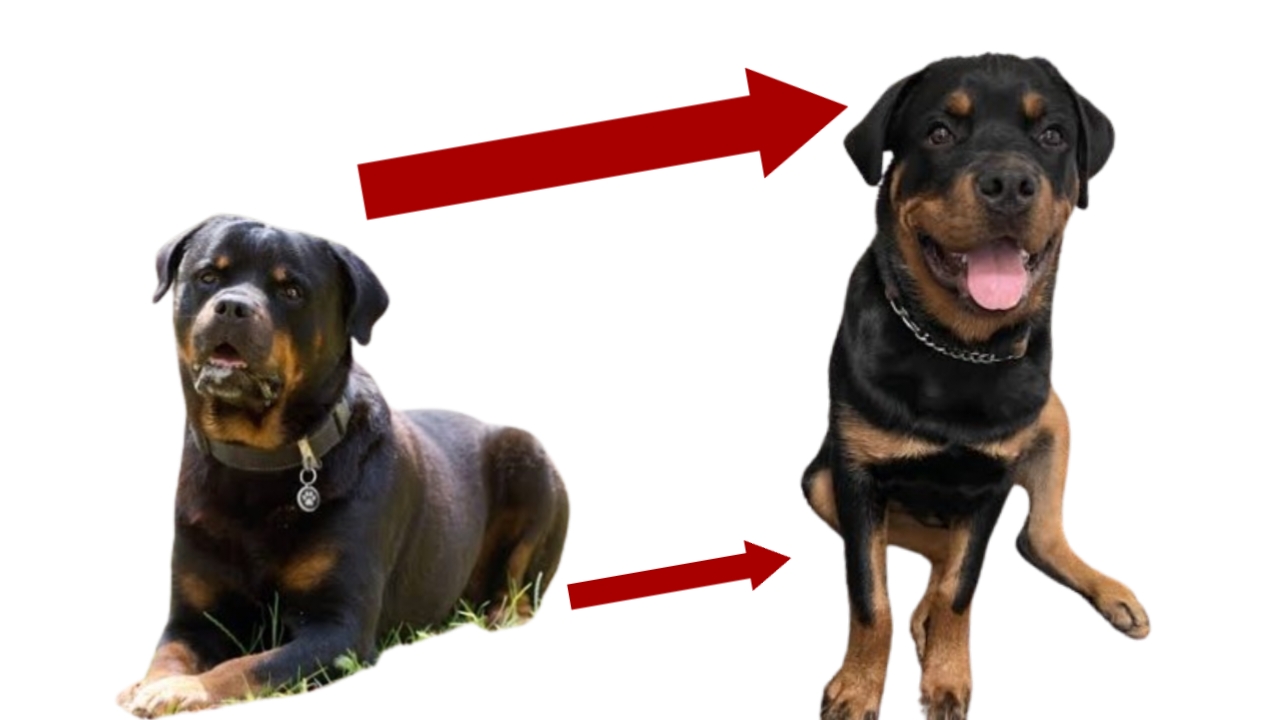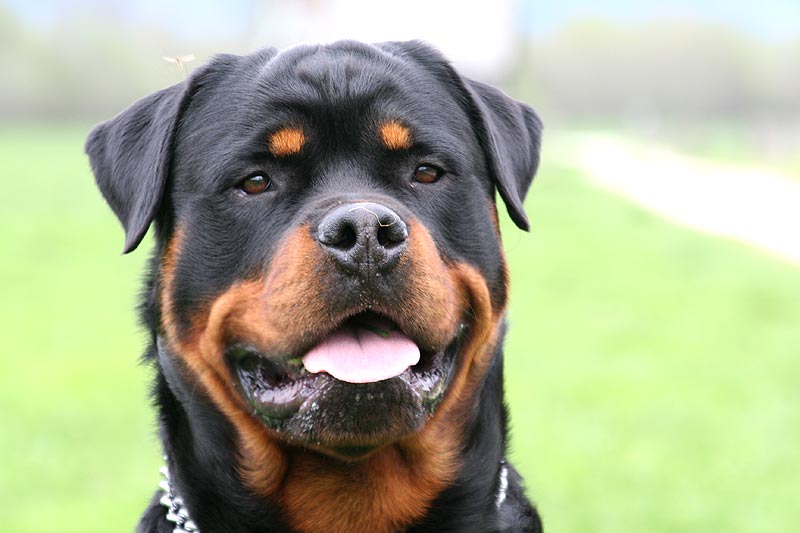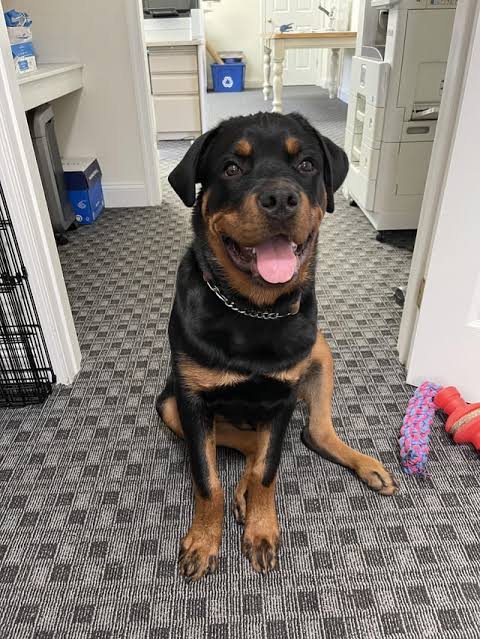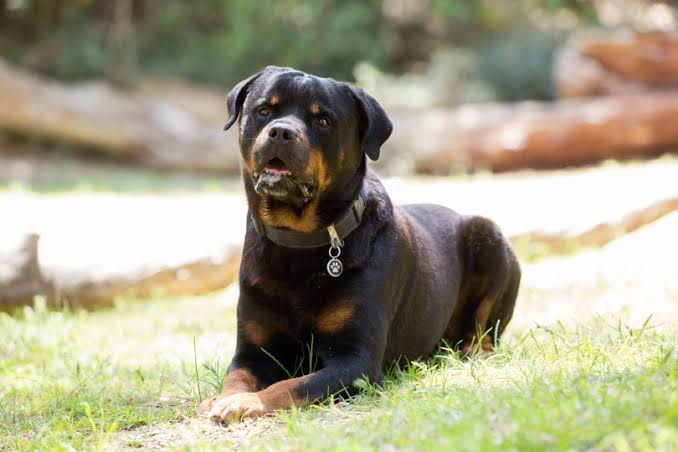
Rottweilers have stunning, majestic heads. To achieve optimal growth, follow these guidelines:
Genetics: Your Rotties’s head size is heavily influenced by genetics. You cannot directly control skull size.
Nutrition: Give your Rottie a well-balanced food full in protein, fat, and carbohydrates. Proper diet promotes muscular and bone growth.
Exercise and Rest: Regular exercise and proper rest promote general growth. Remember to be patient—Rotties might take up to two years to reach full physical maturity. Avoid unnecessary techniques like as including protein or steroids into their diet, as these can be harmful.
What Should the Rottweiler’s Head Look Like?

Rottie’s heads should have the following characteristics:
Broad Appearance: The forehead is reasonably arched, with a well-defined stop.
Strong Jaws: Both the upper and lower jaws are strong.
Straight and Broad Nose: The muzzle is straight and wide at the base.
Broad Nose: The nose should be black in shade.
The ideal Rottwhttps://rottweilerscare.com/category/blog/eiler head is medium-sized, with a large space between the ears and somewhat projecting fronts.
German Rotties have stronger bones and a stockier build, but American Rotties have smaller, narrow skulls and longer legs.
Regardless of breed, a Rottweiler’s head should indicate strength and balance.
Rottweiler Growth Stages

Rottweiler puppies at 0-2 months are tiny and reliant upon their mother’s milk. They start to open their eyes and hear sounds.
Rotties go through several growth stages as they develop into adults. Let’s explore these stages:
3-6 Months: Puppies grow quickly and begin to establish their distinct personalities. Socialization and training are essential during this time.
Juvenile stage (6-12 months): 6-9 months. Rottweihttps://rottweilerscare.com/category/blog/lers may develop independence and arrogance, similar to human teenagers. Regular training and playtime are essential.
9-12 months: Growth slows as they develop.
Adolescent Stage (1-2 years):
Rottweilers appear practically fully grown at 1-1.5 years old yet continue to grow. Coat changes may occur.
1.5-2 years: Muscle development continues, and they establish their responsibilities in the family.
In the adult stage (2+ years), Rotties reach their full size. While muscles may still vary slightly, their height remains constant.
Remember that individual dogs differ, and that proper nutrition, love, and exercise all contribute to healthy growth. This is a weight and height chart for male Rottweilers.
Table
Age (months) Ideal Height (inches) Ideal Weight (lbs)
4 weeks 6-8 5-8
8 weeks 8-10 10-15
6 months 17-20 50-65
1 year 23-27 80-100
2 years 24-27 95-135
Female Rotties follow a similar growth pattern. Keep an eye on your Rottie’s development and enjoy your loyal companion!
Letting the Dog Grow :

Certainly! Ensuring your Rottweiler’s proper growth is critical. Here are some ideas to help your puppy develop:
Rotties’ adult size is heavily influenced by genetics and breed characteristics. Different breeds mature at different speeds.
Smaller breeds typically achieve their full size earlier than larger types.
Nutrition Matters:
Give your puppy a balanced, nutritious diet. High-quality puppy food contains important nutrients for growth.
Avoid overeating, as it can lead to obesity. Underfeeding might result in underweight puppies.
Growth Stages:
Puppy Stage (0-6 months): Rapid growth happens during this time. Socialization and training are critical.
Junior Stage (6-12 months): Puppies continue to grow but at a slower rate.
Adolescent Stage (1-2 years):
Muscle development continues as they settle into their roles.
Rottweilers reach their full size during the adult stage (2 years and older).
Monitor the body’s condition:
Maintain your puppy’s ideal body condition score (4 to 5 on a 9-point scale).
Avoid rapid growth, especially in large breeds, to avoid bone and joint issues.
Remember to see your veterinarian on a regular basis and give a caring atmosphere for your Rottweiler’s healthy growth!
Will my Rottweiler’s head grow?

Certainly! Your Rottweiler’s head will continue to grow as they mature. Here’s what to expect:
First Year:
Rottie puppies go through a growth spurt during their first seven months of life. Their minds and legs develop faster than their bodies.
Lanky Appearance: Between the ages of eight and twelve months, they begin to reach adult height, which may cause them to appear lanky, almost like a bobblehead.
Rotties begin filling out after reaching their full height in the second year, known as stocky development. They gain weight and muscle mass as they mature into adults.
Continued Changes: Their physical appearance, notably the bulk of their head, can still change in size, and their muscles continue to grow.
Third Year:
Final Growth: By the age of two, many Rotties have not reached their full adult weight. They may continue to acquire a few pounds and become more heavy by their third year.
Head Size: By the end of the second year, the head should be nearly full-size. Rottweiler head growth can last for a few more months, but by the end of the third year, both the head and the body will have fully formed and ceased growing.
Remember that individual dogs may differ, but this basic timeline provides insight into your Rottweiler’s development.
How can I make my Rottweiler bigger
To support your Rottweiler’s healthy growth, follow a balanced diet, exercise regularly, consider genetics, and have regular vet checkups. Remember, each Rottie grows differently, so proper care ensures they reach their full potential.
How big is a Rottweiler’s head?
The average skull length of a big male Rottie is six inches, while a big female has slightly more than five inches. Adult males have a skull width of 16 centimeters.
Conclusion :
Rottweilers’ large heads cause slow growth, potentially taking up to two years. Supporting their growth through healthy nutrition, primarily protein and fats, is recommended, as supplements are not effective.